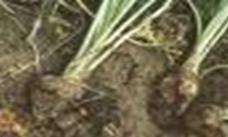Horticultural crops :: Vegetables:: Sweet potato
Bacterial soft rot: Erwinia chrysanthemi
Symptoms
-
Roots are affected in the field, or more commonly in storage, by a soft rot that turns diseased tissue light brown and watery .
-
Lesions on storage roots often have a dark brown margin. Some storage roots appear healthy from the outside but are decayed internally.
-
Infected roots show black streaks in the vascular tissue and eventually undergo a soft, moist decay.
-
Mother roots often decay in plant beds. In the field, brown to black, water-soaked lesions appear on stems and petioles. Eventually, the stem may become watery and collapse, causing the ends of vines to wilt.
-
Usually, one or two vines may collapse, but occasionally the entire plant dies.
Dispersal:
-
The bacterium invades the host through wounds. It survives in crop debris or in association with weeds.
-
Sources of inoculum may include soil, infected mother plants, or contaminated wash water and harvesting equipment.
-
The disease is favored by warm, humid weather.
-
Symptoms may not be visible at temperatures below 80 degrees F but may appear rapidly at temperatures of 86 degrees F or higher.
Management
-
Carefully handle sweet potatoes during all stages of production. This is the most important control method for bacterial soft rot.
-
Select mother roots from fields free of the disease.
-
Cull roots infected during storage.
-
Use vines cut above the soil surface for transplanting.
-
Use a handling system that does not involve immersion of sweet potatoes in water.
|
|
|

